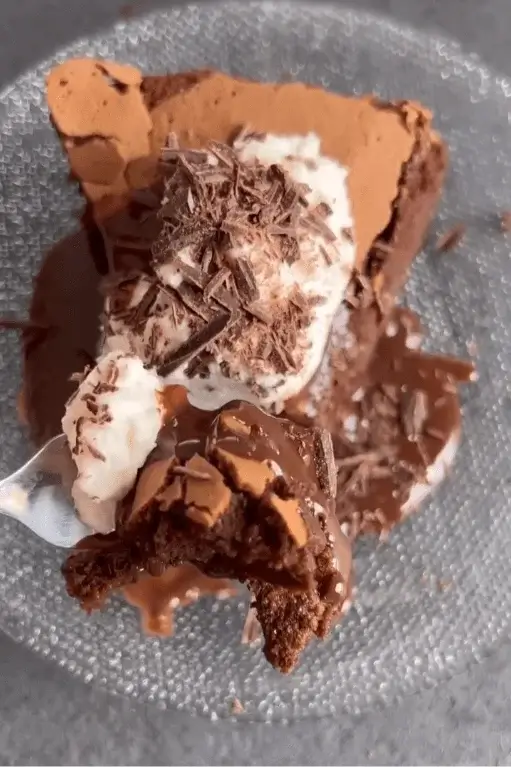Rich Chocolate Soufflé Cake
We may earn a commission from recommended products, at no extra cost to you. See Disclosure.
- Round cake pan
INGREDIENTS
- ½ cup/120 grams butter
- 8 ounces/225 grams dark chocolate
- 6 large eggs, separated
- ½ cup/100 grams sugar
- A pinch of salt
INSTRUCTIONS
- Preheat the oven to 320°F (160°C), static mode.
- In a large bowl, melt the butter and dark chocolate together until smooth. Set aside to cool slightly.
- In a stand mixer fitted with a whisk attachment, beat the egg yolks, a pinch of salt, and ¼ cup (50 grams) sugar on high speed until the mixture is pale, thick, and fluffy. Gently fold the whipped yolks into the melted chocolate mixture until fully incorporated.
- In a clean mixer bowl, whip the egg whites with the remaining ¼ cup (50 grams) sugar until they form stiff, glossy peaks. Using a spatula, carefully fold the whipped whites into the chocolate mixture, working in batches to maintain as much air as possible. The batter should be smooth and uniform but still light.
- Generously butter a 9-inch (22 cm) cake ring or springform pan. If using a cake ring, wrap the bottom tightly in aluminum foil to prevent any leaks. Line the base with parchment paper. Pour in the batter and smooth the top.
- Bake for 30 to 35 minutes, until the edges are set but the center remains slightly wobbly. The cake will firm up as it cools. Do not overbake.
- Let the cake cool completely, then refrigerate for at least 5 hours. Once fully chilled, remove from the mold, slice, and serve.
MY NOTES
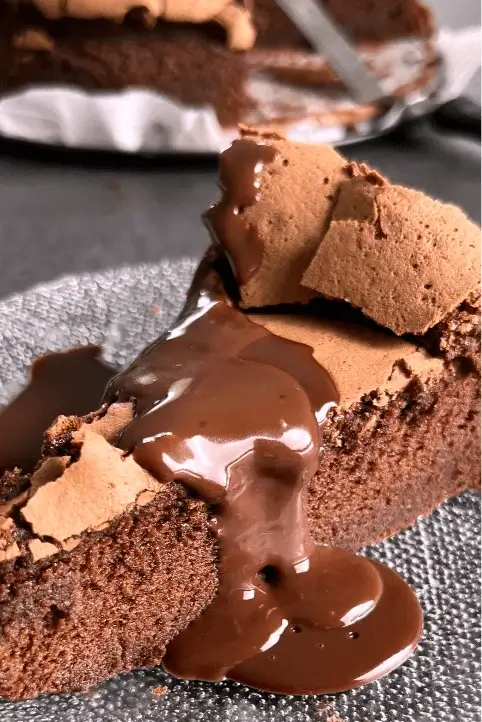
FAQ
The difference between chocolate soufflé cake than a traditional chocolate cake?
This chocolate soufflé cake is flourless, giving it a texture that is much lighter and more delicate than a traditional chocolate cake. Instead of using flour for structure, it relies on whipped egg whites to create an airy, soufflé-like consistency. The result is a cake with a slightly crisp exterior and a soft, almost mousse-like interior. Traditional chocolate cakes typically include baking powder or baking soda for leavening, while this cake depends entirely on the air incorporated into the egg whites. Additionally, it has a more intense chocolate flavor since there are no other dry ingredients to dilute the richness.
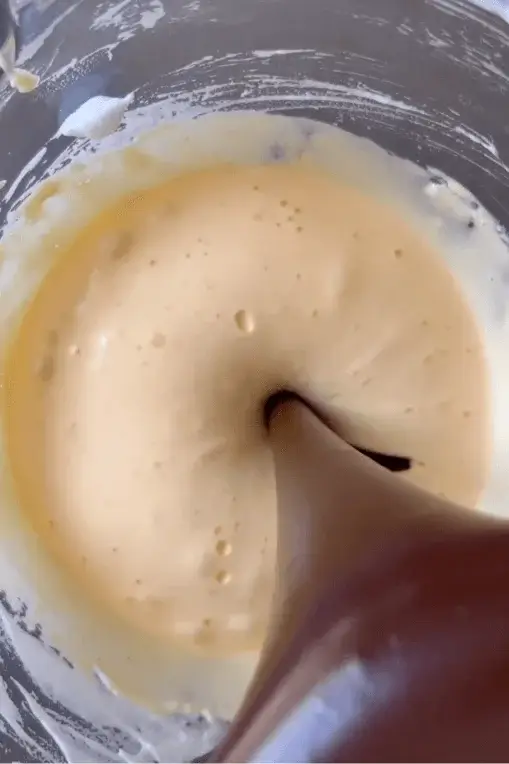
Can I use milk chocolate instead of dark chocolate?
Yes, but it will significantly change the flavor and texture. Dark chocolate has a higher cocoa content and lower sugar, giving the cake a deep, intense chocolate flavor. Milk chocolate contains more sugar and milk solids, which can make the cake overly sweet and alter its consistency. If using milk chocolate, reduce the sugar in the recipe to balance the sweetness. Additionally, milk chocolate has a lower fat content, so the cake may not be as rich or structurally sound. It’s best to use chocolate with at least 60% cocoa to maintain the intended balance of flavor and texture.
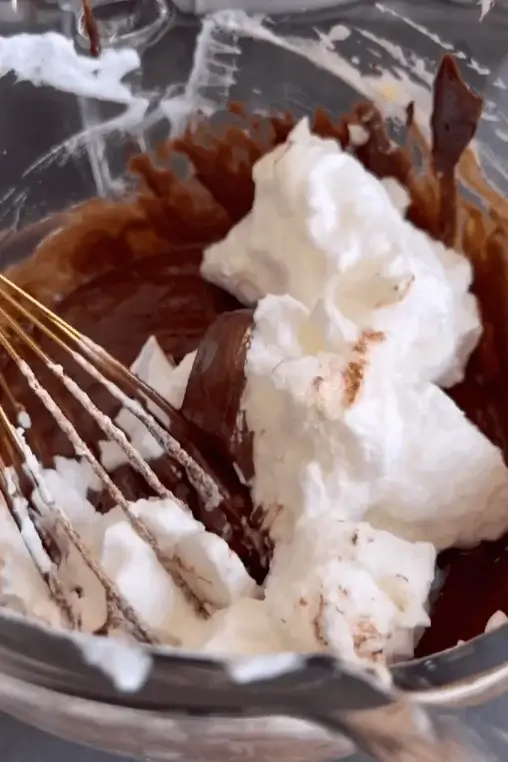
How do I know when the chocolate soufflé cake is done baking?
The chocolate soufflé cake is done when the edges are set and slightly pull away from the pan, but the center remains slightly wobbly when gently shaken. A toothpick test does not work well for this type of cake since the interior should remain soft and fudgy. The top should look slightly cracked, and the cake should rise during baking before settling as it cools. Overbaking will result in a dry, dense cake instead of a delicate, soufflé-like texture. If unsure, it’s better to underbake slightly, as the cake will firm up while chilling in the refrigerator.
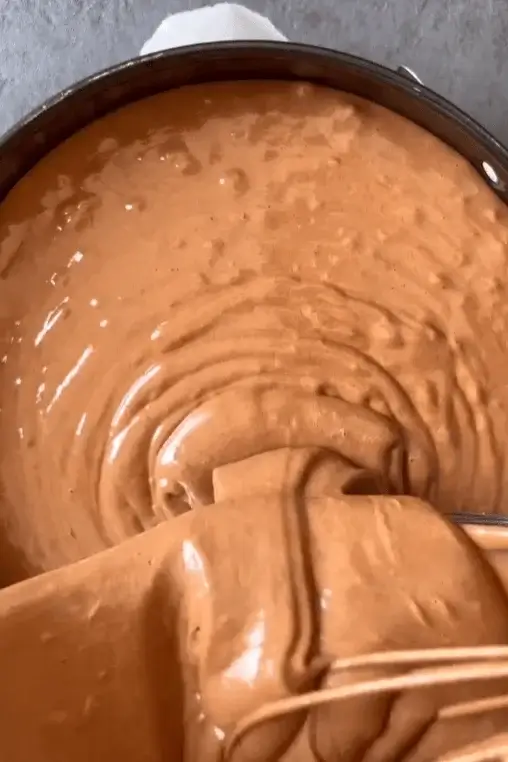
Why is my chocolate soufflé cake sinking in the middle?
This happens when the cake is either underbaked or the egg whites were not properly incorporated. Since the cake relies on whipped egg whites for structure, if they are not beaten to stiff peaks or are overmixed into the batter, they will lose their volume, causing the cake to collapse as it cools. Another cause is opening the oven door too soon, which can cause a sudden drop in temperature, deflating the cake. To prevent sinking, bake until the edges are fully set, allow the chocolate soufflé cake to cool gradually, and avoid rapid temperature changes.
Can I make this chocolate soufflé cake ahead of time?
Yes, this chocolate soufflé cake is ideal for making ahead. It actually improves in texture and flavor after being refrigerated for several hours. Once baked, allow it to cool completely at room temperature before transferring it to the refrigerator for at least 5 hours or overnight. The chilling time helps the cake set properly, making it easier to slice. If making it more than a day in advance, store it in an airtight container to prevent it from absorbing fridge odors. Before serving, let it sit at room temperature for about 15–20 minutes for the best texture.
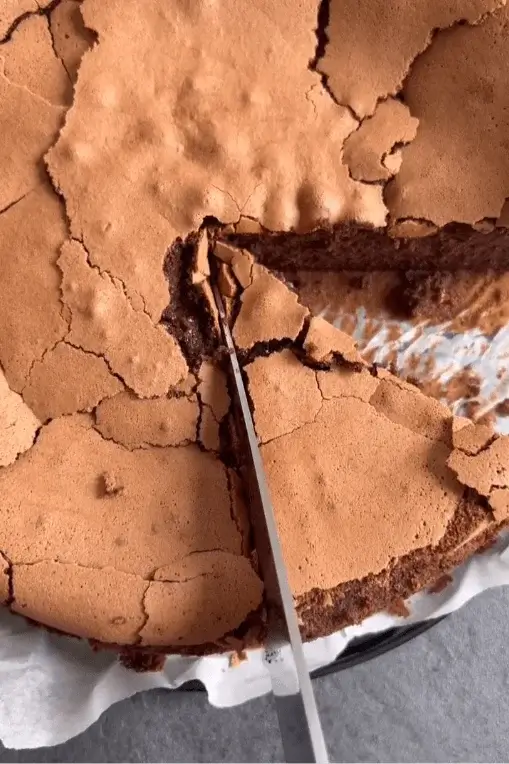
Can I freeze this cake?
Yes, this cake freezes well. Once it has completely cooled and been refrigerated, wrap it tightly in plastic wrap, followed by a layer of aluminum foil, to prevent freezer burn. Store it in an airtight container for up to two months. To thaw, transfer it to the refrigerator overnight, then let it sit at room temperature for about 20 minutes before serving. Freezing may slightly alter the texture, making it a bit denser, but the flavor will remain rich and intense. Avoid freezing individual slices without proper wrapping, as they may dry out.
What can I serve with this chocolate soufflé cake?
This cake pairs well with lightly sweetened whipped cream, fresh berries, or a dusting of cocoa powder. A scoop of vanilla or coffee ice cream can complement the intense chocolate flavor. You can also drizzle it with chocolate ganache or raspberry sauce for added richness. A sprinkle of sea salt or a touch of espresso powder can enhance the chocolate depth. Since the cake is very rich, serving it with something light, like crème fraîche or Greek yogurt, can balance the flavors. A cup of espresso or a glass of dessert wine also makes a great pairing.
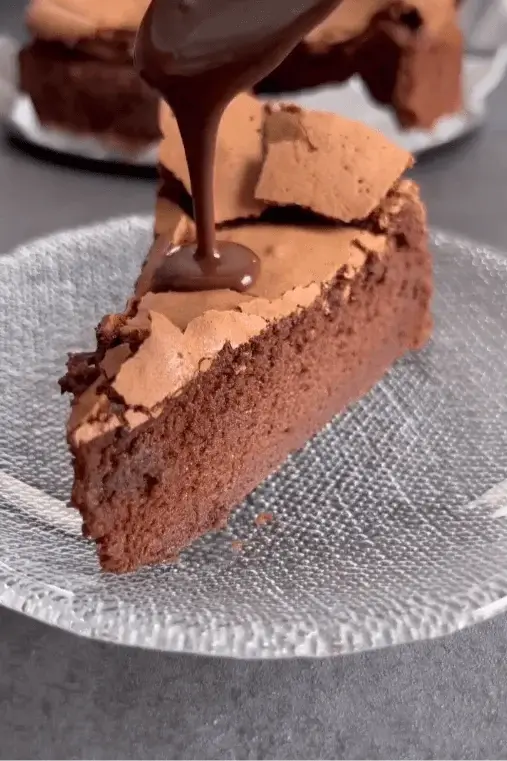
How do I prevent the cake from sticking to the pan?
To ensure easy removal, generously butter the pan, including the sides, and line the bottom with parchment paper. If using a cake ring, wrap the outside with aluminum foil to prevent leaks and ensure a smooth release. Let the cake cool completely before attempting to remove it, as it will be too fragile when warm. Running a knife around the edges before unmolding can also help. If using a springform pan, carefully unlock the sides after refrigeration. If the cake sticks, gently warm the sides with a kitchen towel or a blowtorch for a clean release.
Can I add flavors like coffee or liqueur to the batter?
Coffee and liqueurs enhance the chocolate flavor without overpowering the cake. Adding 1–2 teaspoons of espresso powder or replacing a small portion of the butter with a tablespoon of strong brewed coffee deepens the richness. Liqueurs like Grand Marnier, Kahlúa, or Baileys can be added to the melted chocolate for a subtle flavor boost. If using alcohol, limit it to 1–2 tablespoons to avoid altering the cake’s consistency. A touch of cinnamon, cardamom, or vanilla extract can also add complexity without changing the structure. Always balance added flavors to complement the chocolate, not overshadow it.
